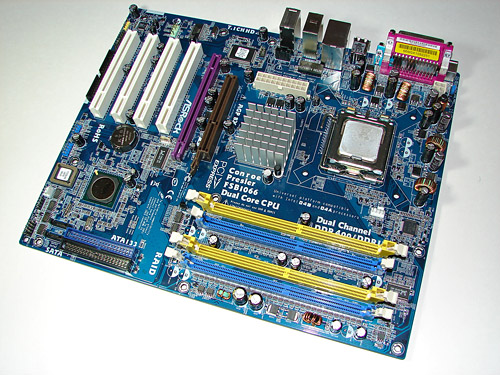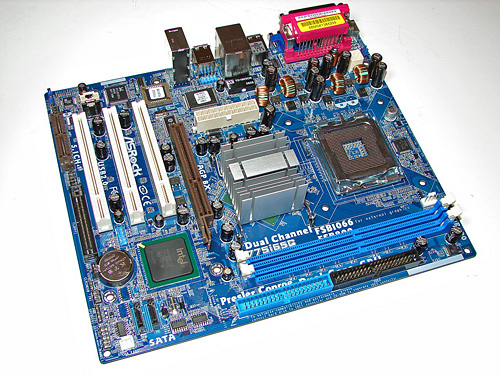ASRock Core 2 Duo: AGP/PCI Express Graphics Performance, Part Tres
by Gary Key on August 15, 2006 6:30 AM EST- Posted in
- Motherboards
System Configuration
Our memory benchmark system uses the following components:
Our test boards represent a blend of performance and pricing requirements for a value-oriented E6300 Core 2 Duo system. The choice of components is designed to provide apples to apples comparison between the PCI Express and AGP capability on our ASRock 775Dual-VSTA platform. We chose the ASRock 775i865G motherboard to provide a comparable AGP system for testing that provided DDR memory capability. We are also only reporting results with DDR memory as the typical user upgrading to either board would probably have both an AGP video card and DDR memory available for use.
Our EVGA 7600GS PCI Express or AGP video card choice represents a very good mid-range alternative and ensures you have respectable game performance at resolutions under 1280x1024 for less than $130. Our EVGA 6800 Ultra tandem represents one of the top performance cards from two years ago and should give a good indication of the performance potential of each graphics slot. Unfortunately, we were unable to procure an ATI X850XT-PE AGP card for comparison with our PCI Express version. However, we doubt there would have been any additional information gained about AGP/PCI-E performance when testing the ATI solutions.
Our feature motherboard is the ASRock 775Dual-VSTA that includes the VIA PT880 Pro Northbridge and VT8237A Southbridge which fully support Core 2 Duo with the proper VRM and BIOS support. The ASRock 775Dual-VSTA is a very unusual board considering all of the available upgrade options and is available at a low entry price of $55.
The board is laid out nicely and certainly caters to those who value IDE and PCI devices. The VT8237A only supports two SATA 1.5Gbps drives but does support four IDE devices. This board also features both AGP 8X capability, PCI-E graphics ability at X4 operation, VIA 10/100 Ethernet LAN, and Realtek ALC-888 HD 7.1 audio. The overall feature set of the VIA chipset is the same as the Biostar PT880 Pro board we reviewed a few months back.
Our other ASRock motherboard is the 775i65G based upon the Intel 865G Northbridge and ICH5 Southbridge with board updates that allow full support for the Core 2 Duo processor series. This motherboard also features on-board graphics capability but requires an external AGP card in order to support the 1066FSB requirement of the Core 2 Duo.
The motherboard utilizes a micro ATX form factor and includes three PCI slots, one AGP 8X slot, one AMR slot, Realtek 10/100 Ethernet LAN, and C-Media 9761a 5.1 Channel audio. The layout is very good and the board is clearly designed for users who want to continue using their AGP video card and DDR memory while upgrading to a newer processor. This motherboard should retail for around US $50 and requires a revision 2 layout for Core 2 Duo compatibility.
Our memory benchmark system uses the following components:
| Performance Test Configuration | |
| Processor: | Intel Core 2 Duo E6300 (Dual core 1.86GHz 2MB Unified Cache) |
| RAM: | 2 x 512MB Patriot DDR-400 (1GB Kit - 2x512 MB) |
| Hard Drive: | Seagate 320GB 7200.10 (16MB Buffer) |
| System Platform Drivers: | VIA 5.09a Intel 8.0.1.1002 |
| Video Cards: | 1 x EVGA 7600GS PCI-E - PCI-E Tests 1 x EVGA 7600GS AGP - AGP Tests 1 x EVGA 6800 Ultra PCI-E - PCI-E Tests 1 x EVGA 6800 Ultra AGP - AGP Tests |
| Video Drivers: | NVIDIA 91.31 |
| CPU Cooling: | Stock Intel Heatsink |
| Power Supply: | OCZ PowerStream 520W |
| Motherboards: | ASRock 775Dual-VSTA (VIA PT880Pro) ASRock 775i865G (Intel 865G) |
| Operating System: | Windows XP Professional SP2 |
| BIOS: | AMI 1.50 - ASRock 775Dual-VSTA AMI 2.50 - ASRock 775i65G |
Our test boards represent a blend of performance and pricing requirements for a value-oriented E6300 Core 2 Duo system. The choice of components is designed to provide apples to apples comparison between the PCI Express and AGP capability on our ASRock 775Dual-VSTA platform. We chose the ASRock 775i865G motherboard to provide a comparable AGP system for testing that provided DDR memory capability. We are also only reporting results with DDR memory as the typical user upgrading to either board would probably have both an AGP video card and DDR memory available for use.
Our EVGA 7600GS PCI Express or AGP video card choice represents a very good mid-range alternative and ensures you have respectable game performance at resolutions under 1280x1024 for less than $130. Our EVGA 6800 Ultra tandem represents one of the top performance cards from two years ago and should give a good indication of the performance potential of each graphics slot. Unfortunately, we were unable to procure an ATI X850XT-PE AGP card for comparison with our PCI Express version. However, we doubt there would have been any additional information gained about AGP/PCI-E performance when testing the ATI solutions.
Our feature motherboard is the ASRock 775Dual-VSTA that includes the VIA PT880 Pro Northbridge and VT8237A Southbridge which fully support Core 2 Duo with the proper VRM and BIOS support. The ASRock 775Dual-VSTA is a very unusual board considering all of the available upgrade options and is available at a low entry price of $55.
 |
| Click to enlarge |
The board is laid out nicely and certainly caters to those who value IDE and PCI devices. The VT8237A only supports two SATA 1.5Gbps drives but does support four IDE devices. This board also features both AGP 8X capability, PCI-E graphics ability at X4 operation, VIA 10/100 Ethernet LAN, and Realtek ALC-888 HD 7.1 audio. The overall feature set of the VIA chipset is the same as the Biostar PT880 Pro board we reviewed a few months back.
Our other ASRock motherboard is the 775i65G based upon the Intel 865G Northbridge and ICH5 Southbridge with board updates that allow full support for the Core 2 Duo processor series. This motherboard also features on-board graphics capability but requires an external AGP card in order to support the 1066FSB requirement of the Core 2 Duo.
 |
| Click to enlarge |
The motherboard utilizes a micro ATX form factor and includes three PCI slots, one AGP 8X slot, one AMR slot, Realtek 10/100 Ethernet LAN, and C-Media 9761a 5.1 Channel audio. The layout is very good and the board is clearly designed for users who want to continue using their AGP video card and DDR memory while upgrading to a newer processor. This motherboard should retail for around US $50 and requires a revision 2 layout for Core 2 Duo compatibility.










43 Comments
View All Comments
deathwalker - Tuesday, August 15, 2006 - link
This review is right on the mark! Very pleased to see this type of review that so closely address's the needs of the budget restricted enthusiast. In my opinion this is one of the best series of reiviews that AT has done in quite some time. I feel far too often that AT is unduely influenced by a small sector of big daddy warbucks system builders in there reiview approach. When in fact it is quiet possible that there are more system builders out there that actually have to feed their families and put a roof over there heads, which comes before there desire to dump the next 2 mortage payments on new computer parts. In closing it is interest to see and also somewhat confirm the feel that many have had about PCIe graphics..its more about hype and marketing than it is about performance. Great job Gary.poohbear - Tuesday, August 15, 2006 - link
“Pairing the motherboard with a top end GPU results in performance that is up to 10% slower than competing motherboards, but it is unlikely anyone would be looking to purchase a $300+ GPU to use with a $50 motherboard.)”there are quite a few owners of the asrock dualsata2 that bought the mobo for its agp 8x support so they dont hafta ditch their 6800GTs/Ultras and later bought a 7900gtx when upgrading (very expensive card for a very cheap mobo). The fact of the matter is all the a64 mobos barely show any difference in performance @ stock because the memory controller is on the cpu, not the chipset anymore. so really, assuming u're running the cpu @ stock, there is no difference in performance between a FX62 on a $250 dfi mobo and a $70 budget Asrock mobo. For overclocking & onboard features, it's a different story.
JarredWalton - Tuesday, August 15, 2006 - link
The statement (made by me and not Gary) applies specifically to the ASRock 775Dual, not any Athlon 64 compatible boards. Also, note that "unlikely" doesn't mean some of you won't do it, but as also pointed out in the statement it is likely to be a temporary situation. Gary also mentioned in the Conroe Buyer's Guide that power delivery is at least something of a concern: "...we had no difficulties running our ATI X1900XTX or EVGA 7900GTX in the board - though we never quite trusted it due to power delivery concerns. The board on a couple of occasions while overclocking completed a brown out while either GPU was being stressed in 3DMark06."Does that mean you shouldn't use the board with a high-end GPU? No. But at the high-end you do lose more performance - as much as an entire CPU bin - and overclocking plus a high-end GPU doesn't appear to be 100% reliable. As a temporary solution? Sure, go for it. As a long term solution to get faster CPU performance? Again, go for it. As a long term to run the latest GPUs - and maybe a G80 or R6xx in the future - I at least would be very hesitant.